Hex River Power Station
One of the most significant events in power supply in South Africa since the establishment of ESCOM, took place at Hex River Power Station on 7 October 1969. With the synchronising of a 132 kV circuit beaker, power flowed via the 400 kV transmission lines into the Western Cape from the power stations at the coalfields in the Eastern Transvaal (now known as Mpumalanga). Generation at Hex River was significantly reduced after this interconnection and the station was finally closed in 1988. The total net energy sent out during the 36 years operating lifetime of Hex River Power Station was 9 128 GWh (gigawatt hours) or 9 128 million units of electricity, and the quantity of coal consumed was 5,285 million metric tons.
During the war years a backlog of generation plant had built up (ESCOM Golden Jubilee 1923 to 1973: 20 and 47). After the war, as well as making extensions to existing power stations, ESCOM was planning seven new power stations, Hex River, Vierfontein, Umgeni, Salt River 2, Taaibos, West Bank 2 and Wilge . Mr Jacobs decided that Hex River, Vierfontein and Taaibos would be designed by ESCOM’s own head office staff, most of whom were previously with the VFP (ESCOM Golden Jubilee 1923 to 1973: 26). Hex River was the first of the new power stations to be commissioned and Mr Jacobs had personally been responsible for the overall design and layout concepts. Hex River became known as “Albert Jacobs’s pride and joy”. It was described by the general manager of a well-known European supplier of steam turbines who had visited the station shortly after the first set had been commissioned as “certainly the best power station design and layout he had seen anywhere in the world” (Conradie and Messerschmidt 2000:260 and 117). Mr Jacobs retired in 1952 (the year the first set was commissioned) and his successor was Dr JT Hattingh.
Parliament passed the Electricity Act of 1922 in September of that year, and the Electricity Supply Commission (ESCOM) was established in 1923 (the name was changed to Eskom in 1987). The Railway Administration was authorised to proceed with the electrification of the Cape Town suburban railway system in 1924, and ESCOM built the Salt River Power Station to supply the power. Salt River Power Station was commissioned in February 1928. By the end of 1933 the main line had been electrified only as far as Bellville. In 1940 ESCOM surveyed a power line route to Worcester over the Du Toit’s Kloof mountains and a 33 kV line was built as far as De Doorns. During 1943 the Railway Administration requested cost estimates from ESCOM for the supply of electricity for the electrification of the Cape main line from Bellville to Touws River, and in 1944 revised estimates were requested for a further 179 miles [288 km] of track as far as Beaufort West. (South African Railways and Harbours Magazine, November 1926:1820, April 1929:526 & General Manager’s Bulletin No.191 of 1933; ESCOM Annual Reports 1927:17&18, 1928:24, 1940:17, 1943:28, 1944:31, 1945:29; South African Electrical Review, February 1947; ESCOM Megawatt No.24/1972:14).
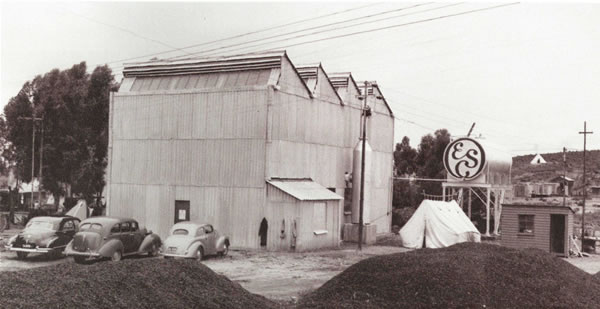
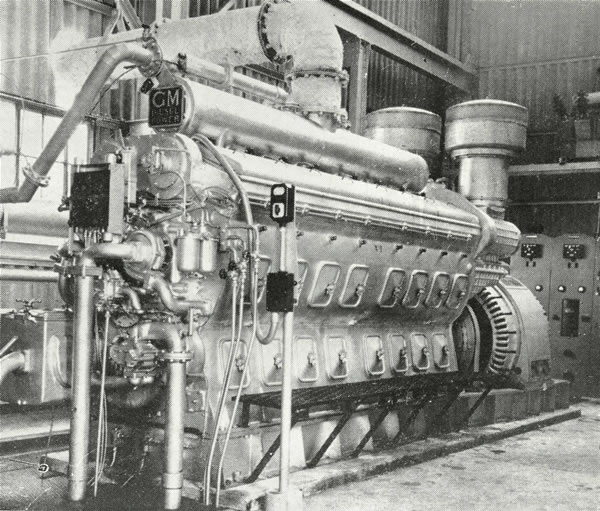
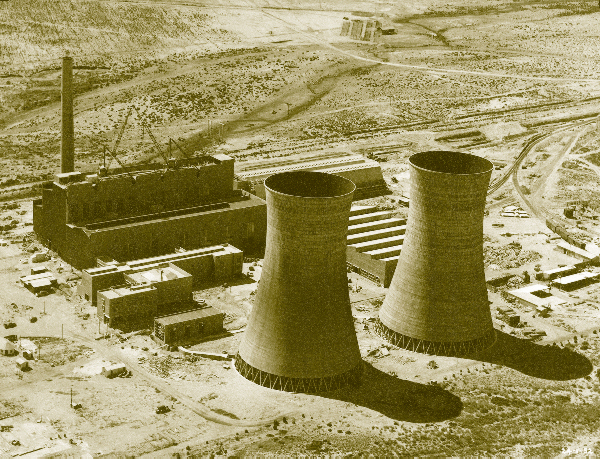
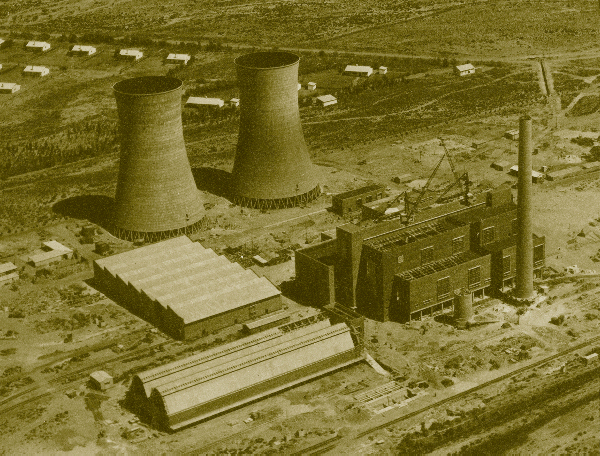
The station under construction (covered coal staithes in foreground)
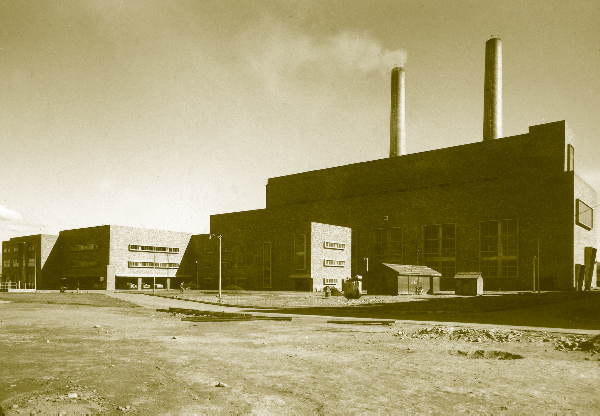
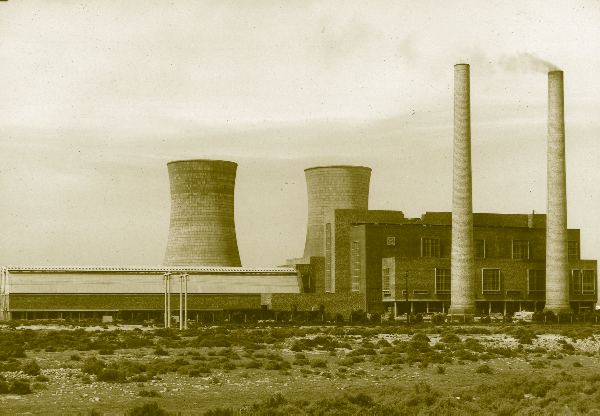
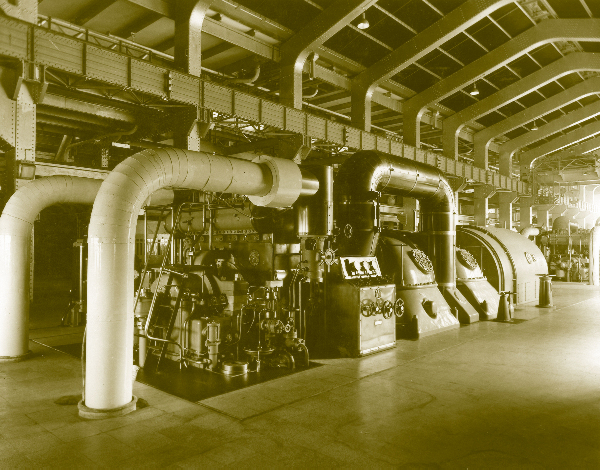
The first generator and boiler were commissioned on 30 May 1952. The second boiler and generator were placed in service in September 1952 and the initial installation, comprising the four boilers and three 20 MW generators was completed and brought into commercial service in April 1953 (ESCOM Annual Report 1953:8). The outstanding construction work was completed in 1954 (ESCOM Annual Report 1954:27).
At the end of January 1954, the 66 kV line between Hex River Power Station and Touws River was completed and the Railways took power for the new section of electrified line in May 1954. (ESCOM Annual Report 1954:27)
Left : One of the 20 MW turbo-generators
(Steam inlet pipes clad in polished stainless steel)
In 1957 survey work was started for two 132 kV transmission lines from Hex River to Beaufort West for the electrification of the Touws River to Beaufort West railway line (ESCOM Annual Report 1957:14). In 1958 it was decided that additional plant should be installed at Hex River in order to meet the growth in demand including the new traction supplies (ESCOM Annual Report 1958:10). Orders were placed for one 275 000 lb/h [34,6 kg/s] spreader-stoker boiler from Messrs. Babcock and Wilcox, and one 30 MW turbo-generator with steam conditions of 600 lb/sq.in. and 900 °F [4,2 MPa (abs) and 482 °C] from English Electric, also a 60 MW cooling tower for commissioning in 1961. Another boiler and turbo-generator were ordered for commissioning in 1963 (ESCOM Annual Report 1959:12 and 27). The work on the foundations for the building and plant was awarded to Messrs Lewis Construction Company. By the end of 1959, they had almost completed this section of the works, and Messrs Dorman Long & Company erected 300 tons of steelwork forming the steel frame building. The contract for the construction of the 60 MW cooling tower was placed with Messrs A Stuart (CWU Annual Report 1959:19).
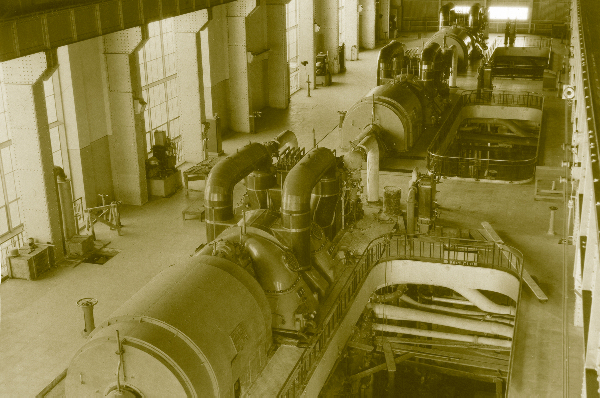
The layout for the step-up yard extension was completed in 1959 and construction work had begun. The 66 kV and new 132 kV sections were interconnected by means of coupling transformers and the new generators connected to the 132 kV busbars through generator transformers. The design of the twelve traction substations for the electrification of the track to Beaufort West was completed and construction work was started early in 1960 (ESCOM Annual Report 1959:27). In 1961 the duplicate 132 kV line, 370 km in length from the Hex River Power Station to Beaufort West and the twelve associated substations, were completed and commissioned, enabling a full electrified train service (ESCOM Annual Report 1961:27). On 23 June 1961 the new 30 MW generator (No 4) was put into service and on 13 July 1961 the new boiler (No 5) was commissioned (ESCOM Annual Report 1961:21).
With the scheduled addition of the 5th generator early in 1963, it became necessary to consider the feeder capacity from the power station towards the heavy load centres around Cape Town. Route location and survey work commenced for a new 132 kV feeder from Windmill substation to Hex River through du Toit’s Kloof, and in 1963 construction work began on this transmission line (ESCOM Annual Report 1962:35 and CWU Annual Report 1963:14)
Boiler No. 6 was completed and ready for steaming at the beginning of September 1963 and generator No. 5 was run up on 23 October 1963 (ESCOM Annual Report 1963:37). The capital costs for the station with all five generators was R115 per kW installed (ESCOM Annual Report 1965:8).
OPERATION
The initial installation of 60 MW of generating plant was completed and brought into commercial service in April 1953 (ESCOM Annual Report 1953:8). Net electricity sent out from Hex River in that year was 163,1 GWh or 43% of the total sold by the Cape Western Undertaking. Total traction sales in the Undertaking (and as a percentage of total sales in brackets) for the years 1951, 1955 and 1958 were approximately as follows: 60 GWh (20%), 160 GWh (30%), and 200 GWh (24%). This increase shows the impact of the electrification of the main line from Bellville to Touws River. Net electricity sent out from Hex River for these years (and the percentage of total sold by the Undertaking in brackets) was approximately as follows: 1951: nil, 1955: 220 GWh (42%), and 1958: 205 GWh (25%). In1955, plant at Hex River was run in the place of the less efficient plant at Salt River 1 Power Station, thus effecting savings in fuel consumption and assisting the pooled stations (Salt River and Table Bay) while special maintenance was being carried out (ESCOM Annual Report 1955:26).
Generator 3 was out of service for seven months in 1956 to allow the contractors to carry out modifications expected to reduce steam consumption (ESCOM Annual Report 1956:27). By 1958 modifications on Generators 2 and 3 had been effected and possibly one half percent on efficiency was gained (ESCOM Annual Report 1958:23).
With the commissioning of Generator 4 and the electrification of the train service to Beaufort West in 1961, traction sales and generation at Hex River increased significantly (see chart).
Construction of the Windmill-Hex River 132 kV transmission line and terminal equipment, started in 1963 and was completed in 1965. The line was initially commissioned at 66 kV during July 1965, but this made a considerable improvement in the transmission capacity of the Worcester-Cape Town network (ESCOM Annual Report 1965:21 and 22).
The year of maximum annual production was in 1966 when 606,5 GWh were sent out (44% of sales in the Undertaking). There had been a breakdown of a generator at Salt River 2 Power Station at the end of 1965, which caused a shortage of generating plant in the Undertaking for almost two years. Even with the maximum generation at Hex River and Salt River 1, the consumers demand could not be met at peak periods without assistance from the Cape Town City Council power stations. When the new 60 MW generators at Salt River 2 came into service in 1967, and the faulty generator had been returned to service, production at Hex River was reduced again. In March and April of 1967 output was reduced by 14% on account of water restrictions enforced by the Worcester Town Council and in 1968 output had dropped to 415,8 GWh (25% of sales in the Undertaking
In October 1969 the first 400 kV transmission line of the national grid from the Northern pooled power stations reached the Droërivier (literally Dry River) Distribution Station near Beaufort West, which was the terminus of the two 132 kV lines from Hex River built to supply power for the Worcester to Beaufort West railway line. One of the most significant events in power supply in South Africa since the establishment of ESCOM, took place when the 132 kV circuit beaker at Hex River was synchronised on 7 October 1969 and power flowed into the Cape Western Undertaking from the power stations at the coal-fields (ESCOM Annual Report 1969:8; ESCOM Megawatt No 15/1969:15). After the interconnection with the 400 kV national network production dropped to below 150 GWh in 1971. There was an increase again between 1975 and 1983 due to general shortage of generation on the ESCOM system, but by 1986 production had dropped to only 6 GWh (from 373,2 GWh in 1981). During December 1986 ESCOM announced that Hex River Power Station was to be finally decommissioned in 1988.
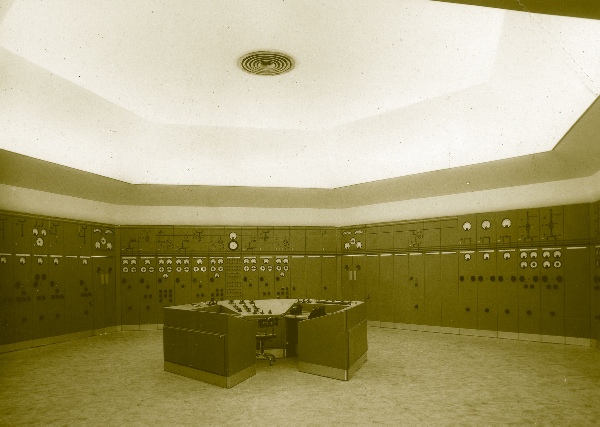
The total quantity of coal consumed at Hex River during its operating lifetime was 5,285 million tons (metric) and the net energy sent out was 9 128 GWh. The maximum power sent out (net) was 119 MW in the year 1966. The best thermal efficiency (net basis) was 25,5% also achieved in the year 1966.
Control room (Generator panels centre, 66 and 132 kV panels left, 11 kV panels right)
Statistics for the years 1953 – the year after commissioning of the first set, 1966 – the year of maximum annual production, and 1987 – the last full year of operating, are as follows:
| YEAR | Net Generation GWh | Net Max Power MW | Load Factor net basis % | Thermal Efficiency net basis % | Coal Consumed metric ton | Calorific Value of Coal MJ/kg | Cost of Coal R/metric ton | Net Water consumption litre/kWh |
| 1953 | 163,091 | 46 | 40,9 | 23,05 | 91 219 | 27,91 | 3,89 | 3,96 |
| 1966 | 606,483 | 119 | 58,1 | 25,5 | 315 632 | 27,14 | 5,57 | 3,19 |
| 1968 | 415,833 | 115 | 41,3 | 24,1 | 233 349 | 26,59 | 6,22 | 3,36 |
| 1971 | 149,075 | 108 | 15,8 | 23,1 | 89 852 | 25,91 | 7,35 | 4,26 |
| 1987 | 13,177 | 63 | 1,5 | 20,2* | 17 075 | 28,23 | Not available | 3,67 |
*While generating
Cost of coal: 1975 R12,40 1977 approximately R20
WATER SUPPLIES
In 1949 it was estimated that the water requirements of Hex River Power Station in 1951/52 would be more or less 300 000 gallons per day [1,3 Ml/d], rising to more or less 1 000 000 gallons per day [4,5 Ml/d] by the years 1954/55. Because of this, a permanent and assured water supply was necessary (Extract from ESCOM’s letter No. 5 of 5 April 1949). In the same year it was decided that the pipeline laid from the Hex River canal to the premises of Hex River Textile Mills Ltd., was to be extended to the Hex River Power Station site. This pipeline delivered 1 025 gallons of water per minute [78 l/s] with a 20 foot [6 m] head at the outlet. This supply was deemed adequate to meet the requirements during 1951/52 of the power station and of Hex River Textile Mills Ltd. (Extract from a letter from the Town Clerk to ESCOM dated 19 July 1949). The pipeline was extended to 6 800 feet [2 km] long in 1950, and supplied water to both the power station and Hex River Textile Mills Ltd.
ESCOM required that there should be a standby pipeline that would be able to supply the power station with its peak requirements at any time (Extract from letter of Consulting Engineer, 7 January 1950). It was therefore decided that a separate Everite water-main would be laid from the Hex River channel, at an estimated cost of £9 500, to supply Hex River Power Station with water. This main was to be interconnected with the existing main at the premises of Hex River Textile Mills Ltd. by means of a T-piece to ensure continuity of supply in case of a breakage in one of the mains (Council Resolution of 30 June 1952). The laying of this pipeline was completed on 31 July 1952 and the connection to the ESCOM supply line was made on 9 August 1952 (Report of the Town Engineer, 11 August 1952).
When the Stettynskloof dam in the Wemmershoek Mountains was completed (built 1954/55 – Standard Encyclopaedia of Southern Africa) Worcester Municipality was able to supply Hex River Power Station either with crude water from the Hex River as before, or with potable water from the new dam. The ESCOM annual reports show that between 1959 and 1972 mostly potable water was supplied. Specific water consumption was between 3,2 and 4,2 litres/kWh depending on load factor (ESCOM Annual Reports).
COAL SUPPLIES
All coal supplies came by rail from the coal-fields in the Witbank area. The main coal stocks were in concrete staithes with cement-sheet roofing (see left foreground in second photograph) and the reclaiming conveyor belts were in underground tunnels. There was no overhead inclined conveyor as at most other stations, the coal being taken vertically by means of a Redler chain conveyor from the underground conveyors to the belt conveyors above the boiler bunkers. The coal supplied was “mixed smalls” (sizing 0 to 25 mm) of calorific value mostly between 27,5 and 26 MJ/kg but sometimes below (the minimum figure was 24,13 MJ/kg in 1977). When there were threats of mining strikes in the 1970s, additional stocks were built up by compacting coal on open ground beyond the staithes. Coal remaining at the end of the operating life of the station was railed to Salt River Power Station. Loading of the coal trucks for this purpose was done by the power station staff using their front-end loader.
ASH DISPOSAL
The power station ash was disposed of by lorries. It was highly sought after by farmers who used it on their lands and for road building. When the station was decommissioned there were no ash dumps remaining.
AWARDS PRESENTED TO HEX RIVER POWER STATION
In its 36 years of service, Hex River Power Station had no fatal accidents. It won numerous awards for “Good Housekeeping”. In 1965 the power station was awarded the first prize for “Good Housekeeping” in the Boland section of the annual contest organised by the National Occupational Safety Association (CWU Annual Report 1965:25). By the end of 1967, Hex River Power Station had operated for 16 months without a lost time accident, and added another cup to their collection for “Good Housekeeping” (CWU Annual Report 1967:26). In 1968 Hex River Power Station was the first ESCOM power station to achieve one million man-hours worked without a lost-time injury and once again they were the winners of the “Good Housekeeping” award (CWU Annual Report 1968:28). They continued their record of “no lost-time injuries” until 11 December 1969 when their record of 1 200 days was broken due to a labourer dropping a piece of steel plate onto his foot, fracturing a toe (CWU Annual Report 1969:14).
Hex River Power Station received a Floating Trophy for the completion of one million man hours without a lost-time injury in 1971. The function was celebrated by all employees at a dinner, which was held on 22 October 1971. The presentation was made by Mr JH Smith, ESCOM’s General Manager, who became Chairman in 1980 (CWU Annual Report 1971:32; ESCOM Megawatt No 22/1971:8).
FACILITIES PROVIDED BY ESKOM
The first step to housing for the employees of Hex River Power Station was taken in 1948 when ESCOM acquired four building sites from Worcester Municipality and built houses on these sites. In the same year, negotiations took place with the Worcester Municipality for the purchase of twenty sites in a new township to be laid out by the Municipality (CWU Annual Report 1948:24). In 1950 twenty-two plots had been purchased for the erection of residential accommodation for the power station staff (ESCOM Annual Report 1950:29).
Single quarters with tennis courts were erected. In 1956 they were modified and a number of rooms converted into five flats, nine rooms being kept for single employees (CWU Annual Report 1956:18). Several other houses were also purchased for the employees over the years.
When Hex River Power Station was built, Worcester already had an established infrastructure and due to this, there was no need for ESCOM to supply medical, educational and religious facilities for their employees in Worcester.
A Social and Sports Club was established in 1954 for the employees of the Hex River Power Station (CWU Annual Report 1957:20). There was also a Sports Centre with two tennis courts, a bowling green and a Jukskei pitch (CWU Annual Report 1960:12; ESCOM Megawatt No 1/1966:10). A swimming pool that was built on the power station site as part of the sports centre was made available to ESCOM staff and families in 1965 (CWU Annual Report 1965:12). A club house with bar facilities was also built after the Central Generating Undertaking was established in 1972.
DECOMMISSIONING AND DEMOLITION
“Like a human being, power stations don’t go on forever.
They both reach the stage of retirement, after many years of good service.
Hex River has reached that stage, and we have come to bid her a nostalgic farewell.”
Dr. I.C McRae
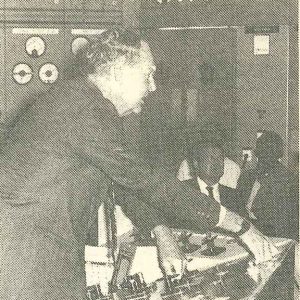
These word from Ian McRae marked a sad day for many people – 10 June when Hex River power station at Worcester was officially de commissioned. As people from near and far gathered in the control room for the last time, one was aware of the respect this great station had earned. The first set was commissioned in May 1952 and amongst her many achievements; Hex River was the first Eskom power station to achieve one million man-hours worked without a disabling injury. 1966 was the year of maximum annual production when 606 million kilowatt hours were sent out and over 315 000 tons of coal were burnt. Gone but not forgotten. Memories of this great station will live forever in the minds of those who knew
Employees were either transferred to other power stations or opted for early retirement. The removing of the asbestos lagging around the boilers and steam pipes was carried out by the power station staff. This work took about two years and was commenced soon after notice of closure of the station had been given. The asbestos was removed strictly in terms of the relevant legislation and was buried at the municipal site for hazardous materials (D Fowler 2000:Interview). When the buildings were demolished, the boilers, turbo-generators and other equipment were sold as scrap. The high voltage yard remained in use as a distribution station (H McLachlan 1999:Interview).
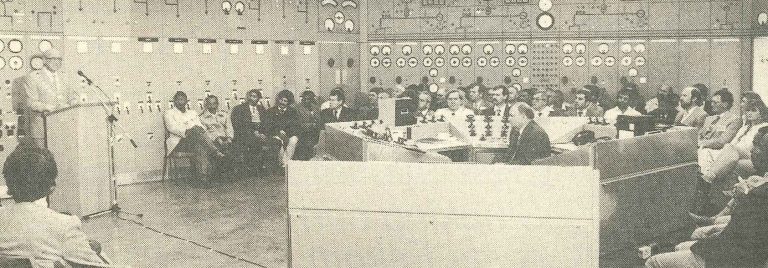
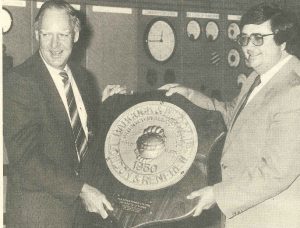
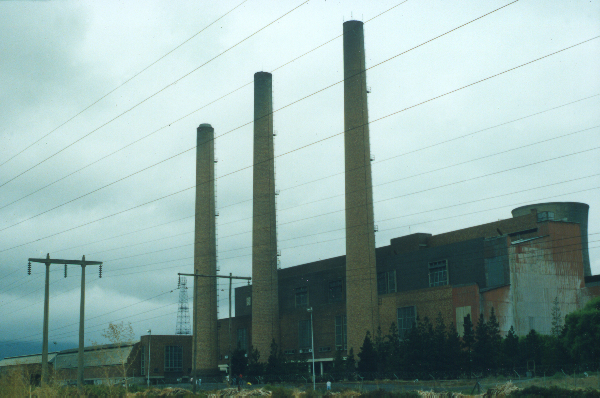
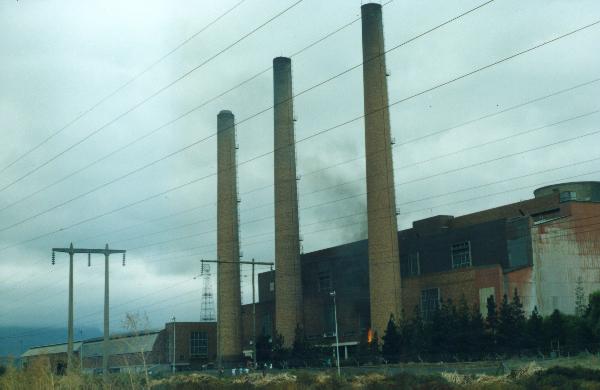
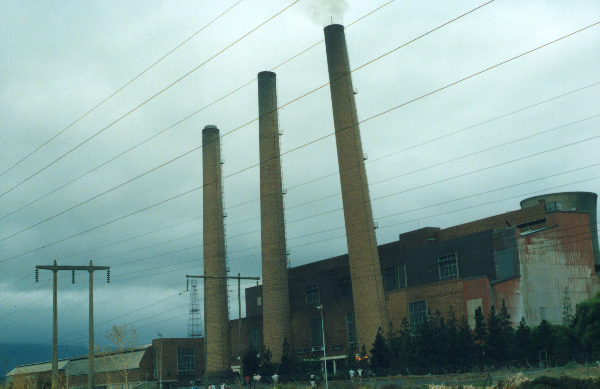
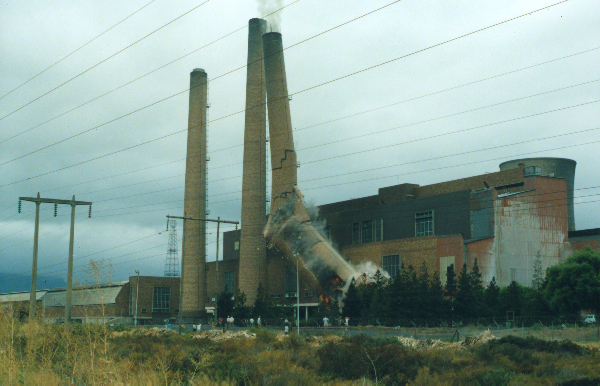
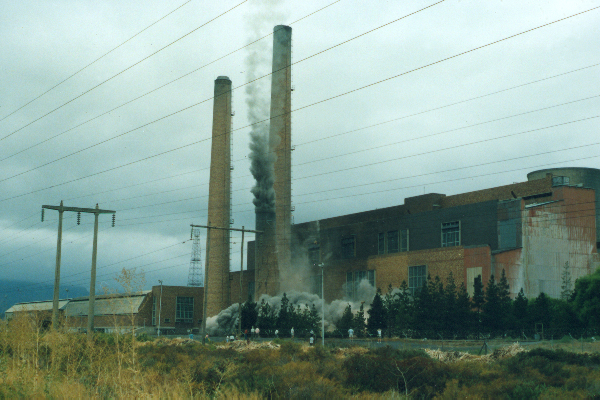
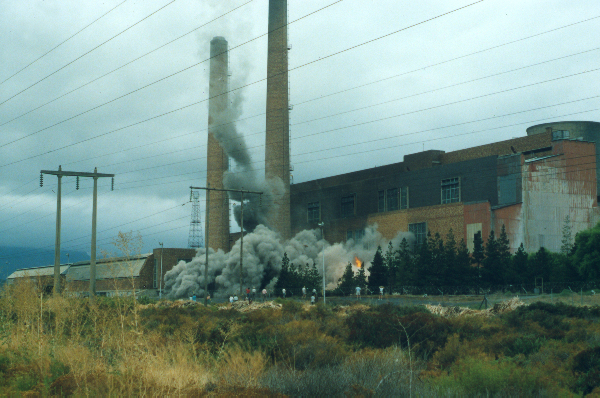
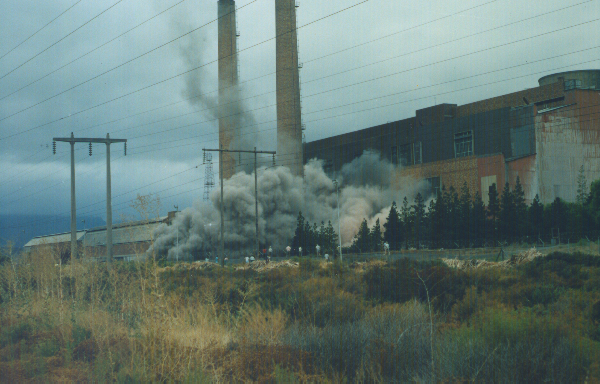
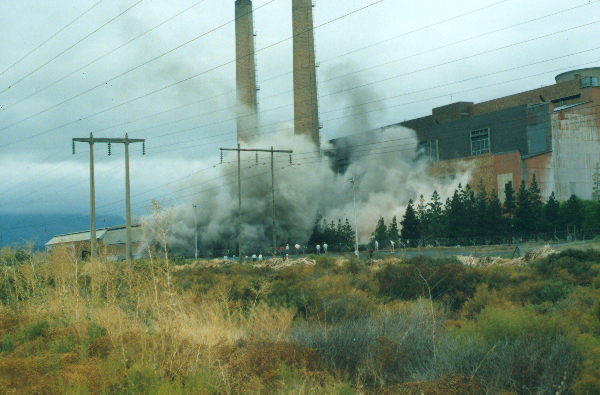
The chimneys were demolished before the rest of the power station because some of the bricks at the top had come loose and were in danger of falling. At that stage there was no point in carrying out repairs. Demolition of the chimneys was done one at a time by a contractor by means of cutting away a sector of the brickwork at the base and wedging in wooden props, similar to mine props. These were doused in oil and then set on fire. The chimney collapsed about 15 to 20 minutes after the fire was ignited.
POWER STATION MANAGERS
Hex River Power Station Managers from the first to the last were: Mr Charles Everett, Mr Laurie Taylor, Mr Ben Lategan, Mr “Jock” Cruickshank, Mr Allen Morgan (Allen Morgan became Chief Executive of ESCOM in 1994), Mr Brian Erasmus, Mr Bill Oakes and Mr Hugo McLachlan (H McLachlan 1999:Interview).
NOTES ON THE NAME HEX RIVER
See The Standard Encyclopaedia of Southern Africa (Vol 5) Page 515
The Hex River originates in the mountains above a fertile and prosperous valley north-east of Worcester, famous for its fruit and vineyards. The old ox-wagon trail criss-crossed the river so many times in its course through the Hex River Poort, about 8 km north-east of Worcester, that the river was called the Ekse River (Afrikaans for ex). This probably became Hekse and then Hex. To the south of Worcester the river becomes a tributary of the Breede (=Broad) River.
See the Nuwe Afrikaanse Kinder Ensiklopedie (Deel 9) Page 329
The legend of the “Heks” (Afrikaans “heks” = witch) of the Hex River Mountains is apparently based on a true story of a beautiful girl, Elize Meiring, for whom no young man was good enough. Eventually someone turned up for whom she cared. But she first sent him into the mountains to pick a blood-red disa high up on the ledges, where he lost his footing and fell to his death. Elize was so distressed that she went out of her mind and one moon-lit evening she climbed the mountain and plunged to her death from the same ledge. Her white “heks” can now supposedly be seen on the mountain ledges on a moon-lit night.
BIBLIOGRAPHY
This information on Hex River Power Station was produced by Narda Gerber, a historical researcher from Stellenbosch University and Dick Fowler, a retired Eskom employee. Dick Fowler has produced additional research material that is available on request (see home page for contact details).
1. ESCOM Annual Reports
2. ESCOM (Cape Western Undertaking) Manager’s Annual Reports
3. ESCOM Statistical Yearbook 1987
4. Eskom Campus 1988
5. Eskom Golden Jubilee 1.3.’23 – 1.3.’73
6. Troost, N. & Norman, H.B. 1969 Electricity Supply in South Africa 1909-1969 (The Transaction of the South African Institute of Electrical Engineers, Sept. 1969).
7. WCG Internal Newsletter June 1988
8. Conradie, SR & Messerschmidt, LJM – A Symphony of Power. The Eskom Story. Johannesburg: Chris Van Rensburg Publications (Pty) Ltd. 2000
9. Hoy, Sir William – Railway Electrification in South Africa. In: South African Railways and Harbours Magazine, May 1922:355-360
10. Merz and McLellan – South African Railways – Report on the Introduction of Electric Traction, June 1919
11. Mills, FW – Electrification of the South African Railways. In: South African Railways and Harbours Magazine, November 1919:737-738
ESCOM: Megawatt/Escom News 1972-1981
South African Railways and Harbours Magazine 1919, 1922
The South African Electrical Review, February 1947
Archival References:
1. History of the water supply to the Hex River Power Station Source 3/WOC, Volume 72, File E53/3
2. Correspondence Files 3/WOC
Interviews:
1. Mr D Fowler, 2000
2. Mr H McLachlan, 1999
